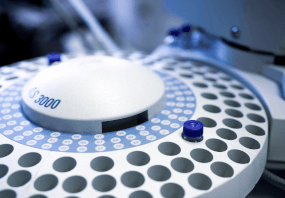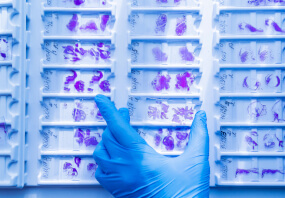General description
Histone H3.1 (UniProt: Q16695; also known as H3K14AcS10P, Histone H3 (acetyl K14, phospho S10), H3 histone family member T, Histone 3, H3, Histone cluster 3, H3) is encoded by the HIST3H3 (also known as HIST1H3A, H3FA, HIST1H3B, H3FL, HIST1H3C, H3FC, HIST1H3D, H3FB, HIST1H3E, H3FD, HIST1H3F, H3FI, HIST1H3G, H3FH, HIST1H3H, H3FK, HIST1H3I, H3FF, HIST1H3J, H3FJ, HIST3H3, H3FT, H3T, MGC126886) gene (Gene ID: 8350, 8351, 8352, 8353, 8354, 8355, 8356, 8357, 8358, 8968) in human. Histone H3 has two main variants, H3.1 and H3.3, which show different genomic localization patterns in animals. The H3.1 and H3.3 complexes also possess distinct histone chaperones, CAF-1 and HIRA, which play important role in mediating DNA-synthesis-dependent and -independent nucleosome assembly. It has been reported that Histone H3.1 serves as the canonical histone, which is incorporated during DNA replication, whereas H3.3 acts as the replacement histone that can be incorporated outside of S-phase during chromatin-disrupting processes like transcription. Histone H 3.1 is a core component of nucleosome that is present only in mammals and is usually enriched in acetylation of Lysine 15 and demethylation of lysine 10 (HeK9Me2). It is expressed during S phase, then expression decreases significantly as cell division slows down during the process of differentiation. Histone H 3.1 expression is shown to be replication dependent. It s presence at the site of UV-induced DNA damage has also been reported. It has also been shown that H3.1/H4 tetramers do not split and remain intact during replication dependent deposition of H3.1 variant. Phosphorylation at serine 10 by aurora kinase B is reported to mediate the dissociation of HP1 proteins (CBX1, CBX3 and CBX5) from heterochromatin and this phosphorylation is considered to be an essential regulatory mechanism for neoplastic cell transformation. Acetylation of lysine 14 of histone H3 (H3K14ac) is shown to be critical for DNA damage checkpoint activation by directly regulating the compaction of chromatin and by recruiting chromatin remodeling protein complex RSC (Remodels the Structure of Chromatin). Nucleosomes with H3K14ac display higher affinity for purified RSC. (Ref.: Stroud, H., et al (2012). Proc. Natl. Acad. Sci. USA 109(14); 5370-75; Dunn, MR., and Smerdon MJ (2014). J. Biol. Chem. 289(12);8353-63)..
Specificity
Broad species cross-reactivity expected.
Recognizes Histone H3 phosphorylated at serine 10 and acetylated at lysine 14, Mr 17 kDa. An unidentified protein is also seen in some cells lines, Mr 40 kDa.
Immunogen
KLH-conjugated, synthetic peptide corresponding to amino acids 7-20 of human histone H3 (ARK[pS]TGGAcKAPRKQL-C).
Application
Anti-phospho (Ser10)-acetyl (Lys14)-Histone H3, Cat. No. 07-081, is a highly specific rabbit polyclonal antibody that targets Histone H3 phosphorylated on Serine 10 and acetylated on Lysine 14 and has been tested for use in Immunocytochemistry, Peptide Inhibition Assay, ChIP-seq and Chromatin Immuno
Research Category
Epigenetics & Nuclear Function
Research Sub Category
Histones
Western Blot Analysis:
1:2000-1:10,000 dilutions of a previous lot detected phosphorylated and acetylated histone H3 in acid extracted proteins from serum starved mouse 10T1/2 cells treated with 50ng/ml EGF for 12.5 minutes. Western blotting of this lot to acid extracted proteins described above was preferentially competed by peptides in the following order: phospho-acetyl-H3 (7-20) > straight chain H3 (7-20) > phospho-H3 (7-20) or acetyl-H3 (7-20).
Peptide Inhibition Analysis: A 1:500 dilution from a representative lot was used with HeLa AE for peptide block analysis.
Chromatin Immunoprecipitation:
A previous lot of this antibody was reported by an independent laboratory to immunoprecipitate chromatin. (Cheung, P., 2000.)
Immunocytochemistry:
A previous lot of this antibody detected phosphorylated and acetylated histone H3 in EGF-stimulated cells; as reported by an independent laboratory. (Cheung, P., 2000.)
Quality
Routinely evaluated by Western Blot on HeLa acid extract.
Western Blot Analysis:
1:500 dilution of this lot detected phospho acetyl Histone H3 on 10 μg of HeLa acid extract.
Target description
17 kDa
Physical form
Immunoaffinity and reverse-affinity chromatography.
Purified rabbit polyclonal IgG in buffer containing 0.2 M Tris-glycine, pH 7.4, 0.15 M NaCl, 0.05% sodium azide, before the addition of glycerol to 30%.
Storage and Stability
Stable for 1 year at -20°C from date of receipt.
Handling Recommendations: Upon first thaw, and prior to removing the cap, centrifuge the vial and gently mix the solution. Aliquot into microcentrifuge tubes and store at -20°C. Avoid repeated freeze/thaw cycles, which may damage IgG and affect product performance. Note: Variabillity in freezer temperatures below -20°C may cause glycerol containing solutions to become frozen during storage.
Analysis Note
Control
Acid-extracted proteins from serum-starved 10T1/2 cells.
Other Notes
Concentration: Please refer to the Certificate of Analysis for the lot-specific concentration.
Legal Information
UPSTATE is a registered trademark of Merck KGaA, Darmstadt, Germany
Disclaimer
Unless otherwise stated in our catalog or other company documentation accompanying the product(s), our products are intended for research use only and are not to be used for any other purpose, which includes but is not limited to, unauthorized commercial uses, in vitro diagnostic uses, ex vivo or in vivo therapeutic uses or any type of consumption or application to humans or animals.
Shipping Information:
Dry Ice Surcharge & Ice Pack Shipments: $40
More Information: https://cenmed.com/shipping-returns
- UPC:
- 12352200
- Condition:
- New
- Availability:
- 3-5 Days
- Weight:
- 1.00 Ounces
- HazmatClass:
- No
- MPN:
- 07-081
- Temperature Control Device:
- Yes












